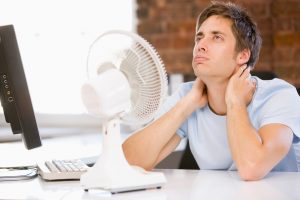 Most people don’t know much about the system they use all summer long. And for the most part, they don’t need to! That’s why we’re here. Our trained technicians go through years of training to ensure they are prepared to fix any AC problem you may come across, or to install an air conditioner that fits your home perfectly.
Most people don’t know much about the system they use all summer long. And for the most part, they don’t need to! That’s why we’re here. Our trained technicians go through years of training to ensure they are prepared to fix any AC problem you may come across, or to install an air conditioner that fits your home perfectly.
Still, it’s nice to know where all that comfort comes from, and to have the information you need to make an informed decision about when it may be time to repair or replace your air conditioner. That’s why we’ve provided some important information that can help you understand your home’s central AC a little better.
#1: Air conditioners remove heat from the air
A furnace can generate, or create, heat. “Heat” is an energy, which means it is something that can be produced (via combustion, electric resistance, or some other method). However, “cool” is not an energy form. In fact, “cold” is simply the absence of heat.
Therefore, an air conditioner cannot really “create” cooling. However, it can remove heat in order to create conditions for cool air. Here’s how it works.
- Refrigerant cycles throughout your indoor and outdoor components, changing pressure as it does. It condenses (turns to liquid form) at the outside unit, and evaporates (turns into a gas) indoors, over and over again.
- As it evaporates, refrigerant, a chemical blend, is able to remove heat from the air.
- This cools down the evaporator coil within the system, cooling the air as warm air from the house blows over it.
- The heat absorbed by the refrigerant is released outdoors at the condenser coil. However, refrigerant itself should not leak out of the system.
#2: An air conditioner dehumidifies as well
Heat isn’t the only thing your air conditioner can remove from the air. It can also take away some of the moisture in the air that makes your home feel even warmer. In fact, the earliest air conditioners were designed in order to dehumidify in order to improve conditions within a printing plant.
Excess moisture in the air makes you feel hot because sweat cannot evaporate from your body so easily when there is moisture in the air—and this is how your body typically is able to regulate temperatures in the summer time. Thankfully, some moisture can condense onto the evaporator coil of your AC system as it cools, draining through a drainage pipe that leads outside of the home.
It is worth noting, however, that drainage pipes may backup if they are clogged with dirt and debris. That’s just part of why it’s so important to schedule AC maintenance once a year!
#3: Most air conditioners cool at only one speed
Many people think that if they turn the temperature down as low as it will go on the thermostat, the house will get cooler faster. But this simply is not true. Most air conditioners only move at one speed: 100%. That means the air conditioner starts up when the thermostat calls for more cooling and stops when it hits the setting on the thermostat.
If you turn the thermostat all the way down to 65°, you are only wasting energy making the home cooler than you need. Instead, use a programmable thermostat or even a smart thermostat that connects to the Wi-Fi to keep the home at about 78°F while you are home. Schedule the settings to adjust by 10° when you are away, to save money, but make sure they automatically restore your preferences around 20 minutes before you plan to arrive home!
Contact Johansen & Anderson Inc for your next AC repair in Joliet, IL.
